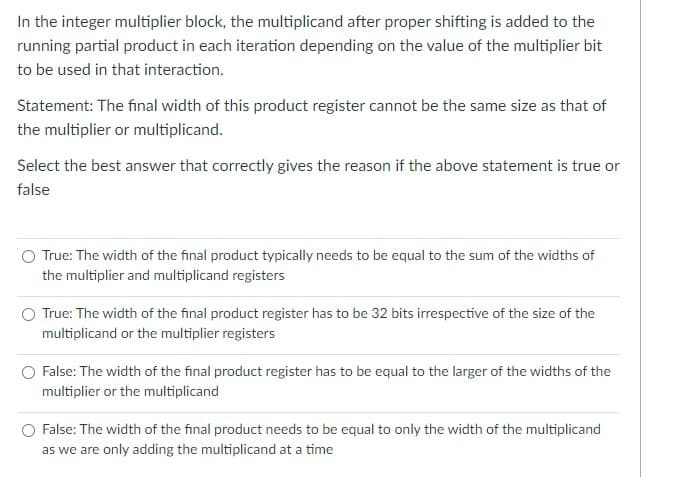In the integer multiplier block, the multiplicand after proper shifting is added to the running partial product in each iteration depending on the value of the multiplier bit to be used in that interaction. Statement: The final width of this product register cannot be the same size as that of the multiplier or multiplicand. Select the best answer that correctly gives the reason if the above statement is true or false O True: The width of the final product typically needs to be equal to the sum of the widths of the multiplier and multiplicand registers O True: The width of the final product register has to be 32 bits irrespective of the size of the multiplicand or the multiplier registers False: The width of the final product register has to be equal to the larger of the widths of the multiplier or the multiplicand O False: The width of the final product needs to be equal to only the width of the multiplicand as we are only adding the multiplicand at a time
In the integer multiplier block, the multiplicand after proper shifting is added to the running partial product in each iteration depending on the value of the multiplier bit to be used in that interaction. Statement: The final width of this product register cannot be the same size as that of the multiplier or multiplicand. Select the best answer that correctly gives the reason if the above statement is true or false O True: The width of the final product typically needs to be equal to the sum of the widths of the multiplier and multiplicand registers O True: The width of the final product register has to be 32 bits irrespective of the size of the multiplicand or the multiplier registers False: The width of the final product register has to be equal to the larger of the widths of the multiplier or the multiplicand O False: The width of the final product needs to be equal to only the width of the multiplicand as we are only adding the multiplicand at a time
Fundamentals of Information Systems
8th Edition
ISBN:9781305082168
Author:Ralph Stair, George Reynolds
Publisher:Ralph Stair, George Reynolds
Chapter6: Information And Decision Support Systems
Section: Chapter Questions
Problem 3LO
Related questions
Question
I need correct answer with correct reason why correct and why incorrect. Don't give direct answer for correct one.

Transcribed Image Text:In the integer multiplier block, the multiplicand after proper shifting is added to the
running partial product in each iteration depending on the value of the multiplier bit
to be used in that interaction.
Statement: The final width of this product register cannot be the same size as that of
the multiplier or multiplicand.
Select the best answer that correctly gives the reason if the above statement is true or
false
O True: The width of the final product typically needs to be equal to the sum of the widths of
the multiplier and multiplicand registers
True: The width of the final product register has to be 32 bits irrespective of the size of the
multiplicand or the multiplier registers
O False: The width of the final product register has to be equal to the larger of the widths of the
multiplier or the multiplicand
False: The width of the final product needs to be equal to only the width of the multiplicand
as we are only adding the multiplicand at a time
Expert Solution
This question has been solved!
Explore an expertly crafted, step-by-step solution for a thorough understanding of key concepts.
This is a popular solution!
Trending now
This is a popular solution!
Step by step
Solved in 2 steps with 1 images

Knowledge Booster
Learn more about
Need a deep-dive on the concept behind this application? Look no further. Learn more about this topic, computer-science and related others by exploring similar questions and additional content below.Recommended textbooks for you

Fundamentals of Information Systems
Computer Science
ISBN:
9781305082168
Author:
Ralph Stair, George Reynolds
Publisher:
Cengage Learning

Fundamentals of Information Systems
Computer Science
ISBN:
9781305082168
Author:
Ralph Stair, George Reynolds
Publisher:
Cengage Learning